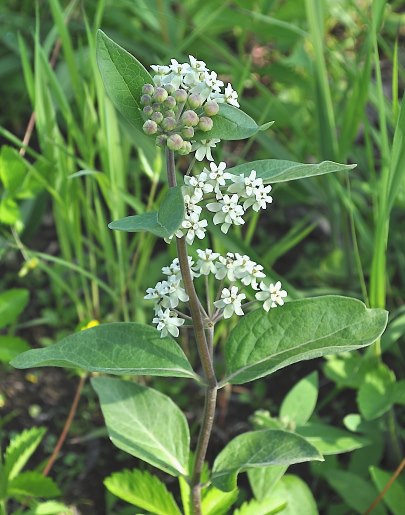Description: This perennial wildflower is 8-20" tall, erect, and unbranched. The central stem is light green to brown, terete, and canescent to short-pubescent. Pairs of opposite leaves occur at intervals along the central stem. The leaf blades are 2-3" long and ¾–1½" across; they are lanceolate, ovate, or oval in shape and their margins are smooth. The upper surfaces of the blades are green and hairless, while their lower surfaces are pale green and canescent to short-pubescent. On each blade, the lateral veins extend outward from the central vein toward the outer margins. The petioles are about ¼" in length. The central stem terminates in a a dome-shaped umbel of flowers about 1½–2" across; there are usually 1-3 additional umbels of flowers that develop from the axils of the upper leaves. Each umbel has 8-24 flowers that are more or less white. Individual flowers are about ¼" across, consisting of a short reproductive column in the center, 5 surrounding hoods with inwardly curving horns, and 5 drooping corolla lobes. The hoods are white or cream-colored, while the corolla lobes are white, greenish white, or pale purplish white. The slender pedicels of the flowers are about ¾–1" long and short-pubescent.

The blooming
period occurs from late spring to mid-summer and lasts about 3 weeks.
Fertilized flowers are replaced by spindle-shaped seedpods (follicles)
about 2-3" long that have smooth and canescent outer surfaces. These
seedpods are held erect. At maturity, each seedpod splits open along
one side, releasing seeds with tufts of light brown hair. The seeds are
distributed by the wind. The root system is rhizomatous.
Cultivation:
The preference is full or partial sun, dry conditions, and sandy soil;
other kinds of soil are tolerated, if water drainage is good. This
small milkweed could be cultivated in rock gardens.
Range & Habitat:
The native Oval-Leaved Milkweed is rare in Illinois and state-listed as
endangered; it is found in only a few northeastern counties. This
milkweed is more typical of prairies in the northern plains; Illinois
lies at the southeastern limit of its range. Habitats include hill
prairies and dry sand prairies, typical savannas and sandy savannas,
and openings in upland oak
woodlands. Occasional wildfires are probably
beneficial as this reduces the encroachment of woody vegetation.
Oval-Leaved Milkweed is found in high quality natural areas.
Faunal Associations:
The nectar of the flowers attracts many kinds of insects, including
long-tongued bees, wasps, ants, butterflies and skippers, and probably
some moths. Ants are nectar robbers, but they may provide the flowering
plant with some protection from aphids and other small insects. Little
information about floral-faunal relationships is available for this
milkweed specifically, but in general milkweed species (Asclepias spp.)
attract a distinctive group of insects that feed on the leaves and
other parts of these plants. These insect feeders include the weevil Rhyssomatus
lineaticollis, Lygaeus kalmii (Small
Milkweed Bug), Oncopeltus fasciatus (Large Milkweed
Bug), Tetraopes basalis (Milkweed Longhorn), Tetraopes
femoratus (Large Red Milkweed Beetle), Tetraopes
tetrophthalmus (Red Milkweed Beetle), Aphis nerii
(Introduced Milkweed Aphid), the aphids Myzocallis asclepiadis
and Myzocallis punctatus, the moths Cycnia
inopinatus (Unexpected Cycnia) and Cycnia tenera
(Delicate Cycnia), and the butterfly Danaus plexippus
(Monarch). Because the foliage is toxic and bitter as a result of its
milky latex, mammalian herbivores usually avoid milkweeds. Sometimes,
the Eastern Goldfinch uses the tufted hairs of the seeds in the
construction of its nests.
Photographic Location:
A nature preserve in Cook County, Illinois. The photograph of the
flowering plant was taken by Lisa Culp (Copyright © 2009).
Comments:
This little-known milkweed has reasonably attractive flowers and
foliage. It is one of several milkweeds (Asclepias spp.) in Illinois
with flowers that are more or less white. To identify Oval-Leaved
Milkweed correctly, the following two characteristics should be
considered: 1) its stems and leaf undersides are canescent or
short-pubescent, rather than hairless or long-haired, and 2) its larger
leaves are usually ovate to oval, rather than linear or lanceolate. For
example, the white-flowered Asclepias lanuginosa
(Woolly Milkweed) has more slender leaves and its stems are covered
with spreading hairs. This latter milkweed produces only a single
terminal umbel of flowers per plant, while Oval-Leaved Milkweed often
produces 1-3 axillary umbels of flowers. Other common names of Asclepias
ovalifolia are Dwarf Milkweed and Oval Milkweed.